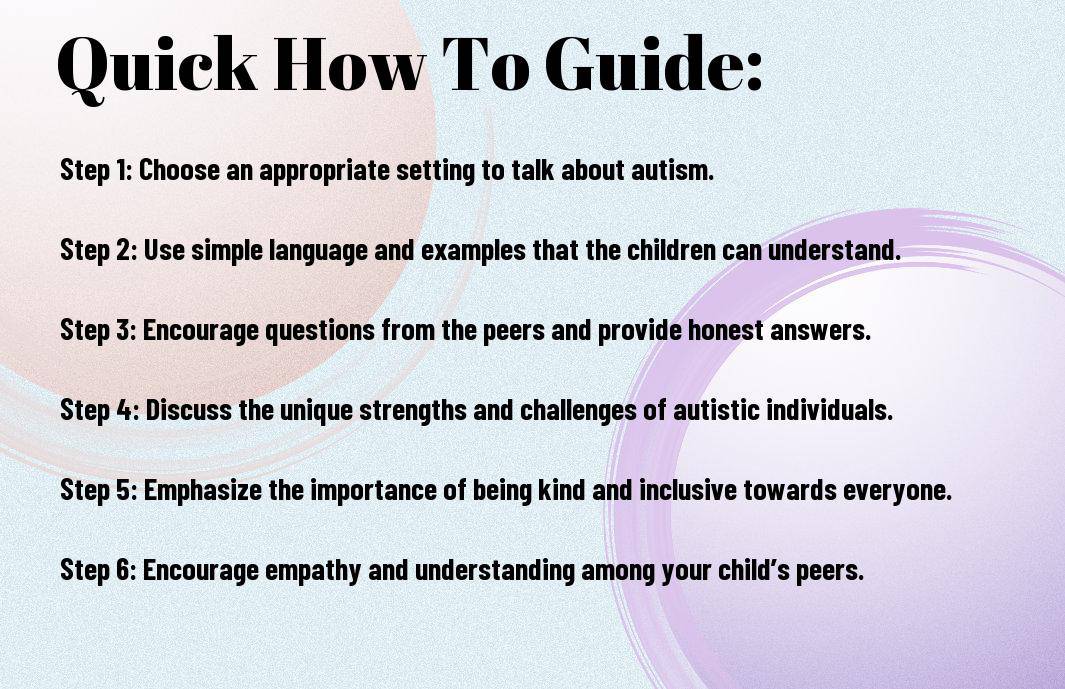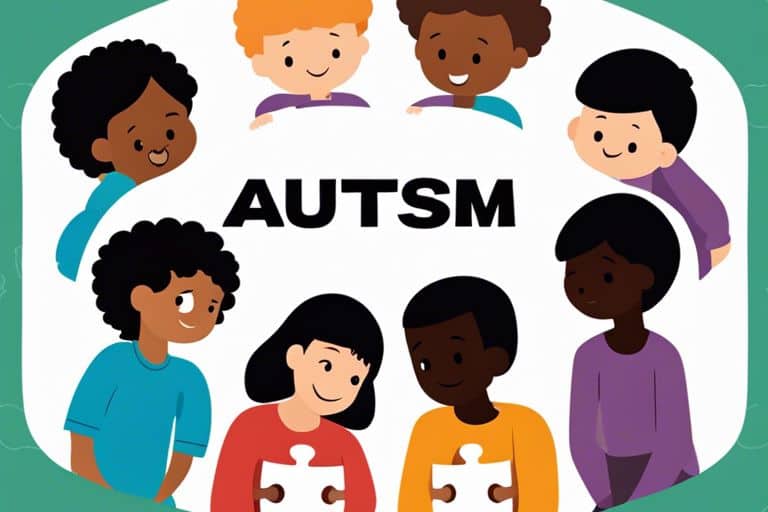As parents, it is our responsibility to educate our child’s peers about autism in order to promote understanding and acceptance. It is essential to approach this conversation with empathy and clarity, as the way we explain autism to others can greatly impact how they interact with and support our children. When discussing autism with your child’s peers, be honest, but also focus on highlighting the positive attributes and unique strengths of individuals with autism. In addition, it’s important to address any misconceptions or misunderstandings they may have about autism, and provide them with resources to learn more. By having these open and educational conversations, we can foster a supportive environment for children with autism in their social circles.
Key Takeaways:
- Be transparent: It is important to be open and honest about autism with your child’s peers. Encourage questions and provide age-appropriate answers to help them understand the condition.
- Emphasize differences: Teach children to embrace and celebrate differences in others, including those with autism. Encourage empathy and understanding towards their peers with autism.
- Encourage inclusivity: Foster an inclusive environment where children with autism feel accepted and supported. Encourage friendships and connections between all children, regardless of their differences.

Preparing the Explanation
Before talking to your child’s peers about autism, it’s important to carefully prepare the explanation. This will help ensure that the information is presented in a way that is understandable and respectful. By taking the time to consider important factors and gather appropriate resources, you can help facilitate a positive and informed conversation about autism.
Factors to Consider Before Talking to Peers
When preparing to explain autism to your child’s peers, there are several factors to consider:
- Age and maturity level: Each peer may have a different level of understanding, so consider how best to tailor the explanation to their age and maturity.
- Cultural and religious background: Be mindful of potential cultural or religious beliefs that could influence the way autism is perceived.
- Timing and setting: Choose an appropriate time and setting for the conversation, ensuring privacy and minimal distractions.
Any misconceptions or fears about autism can be addressed by providing accurate information and creating a supportive environment for discussion.
Gathering Resources
When discussing autism with your child’s peers, having access to educational materials and resources can be invaluable. Consider obtaining books, videos, or online resources that explain autism in a clear and accessible manner. These materials can help facilitate a deeper understanding of autism and provide a basis for open and informed discussion.
By gathering resources ahead of time, you can ensure that you are well-prepared to address any questions or concerns that may arise during the conversation about autism.

How to Approach the Topic with Children
When explaining autism to your child’s peers, it’s important to approach the topic with sensitivity and understanding. It’s essential to create a safe and inclusive environment where all children can learn and grow together. For a comprehensive guide on how to explain autism to kids, check out How to Explain Autism to Kids: 5 Tips for Parents.
Age-Appropriate Explanations
When discussing autism with children, it’s crucial to tailor your explanations to their age and developmental level. Younger children may benefit from simple, concrete explanations, while older children can grasp more complex concepts. By providing age-appropriate information, you can help children understand and accept individual differences and diverse needs.
Using Relatable Scenarios
Using relatable scenarios can be a helpful way to explain autism to your child’s peers. By using familiar situations or examples, children can better understand how autism may affect their classmates. This approach can promote empathy, compassion, and a greater sense of understanding among peers.
Engaging children in discussions about autism through relatable scenarios can also encourage open-mindedness and respect for neurodiversity. It can foster a positive and inclusive environment where all children feel valued and understood.
Tips for a Successful Discussion
When explaining autism to your child’s peers, it is important to approach the discussion with sensitivity and empathy. Here are a few tips to ensure that the conversation is positive and educational:
- Begin with a clear, positive message about autism and emphasise the importance of acceptance.
- Encourage questions and open dialogue, and be prepared to address any misconceptions.
- Utilise visual aids or simple language to ensure that the information is easily understandable.
- Emphasise the similarities between children with autism and their peers, rather than focusing on differences.
Encouraging Empathy and Compassion
When discussing autism with your child’s peers, it is crucial to encourage empathy and compassion. Discuss the challenges that children with autism may face, and highlight the importance of kindness and inclusivity. By fostering a sense of understanding and empathy among their peers, you can create a more supportive and inclusive environment for your child.
Addressing Common Questions and Misconceptions
During the discussion, be prepared to address common questions and misconceptions about autism. Encourage an open and non-judgemental atmosphere, and provide accurate information to dispel any misunderstandings. Utilise this opportunity to educate your child’s peers and promote a greater understanding of autism in the community.
It is important to emphasise that autism is a neurological difference and not a deficiency. By addressing misconceptions and providing accurate information, you can help create a more accepting and inclusive environment for all children.
Supporting Ongoing Understanding and Inclusion
When it comes to explaining autism to your child’s peers, supporting ongoing understanding and inclusion is crucial. It is important to have open and honest conversations with all children involved, to ensure they feel included and informed. One way to do this is by providing them with resources such as How Do You Explain Autism To A Child Without Autism? which can help them gain a better understanding of autism. Encouraging questions and open dialogue can also be beneficial in creating a supportive environment.
Activities to Foster Inclusion
Engaging in activities that promote inclusion and understanding can be incredibly valuable. Organising games and group activities that encourage teamwork, empathy, and communication can help foster a sense of inclusivity among peers. Additionally, involving children in activities that highlight the strengths and talents of their autistic peer can help them appreciate and embrace their differences.
Creating an Accepting Environment
Creating an accepting environment involves promoting empathy, understanding, and respect for differences. Encouraging children to celebrate diversity and individuality can help create an inclusive and supportive atmosphere. It is important to address and challenge any misconceptions or prejudices that may arise, and to continuously reinforce the importance of acceptance and inclusivity.
By implementing these strategies, you can create an environment that promotes understanding, empathy, and inclusion, ultimately fostering a positive and supportive community for all children involved.

How to Explain Autism to Your Child’s Peers
It is crucial for parents and educators to effectively communicate with their child’s peers about autism in order to create an inclusive and understanding environment. By providing age-appropriate information, using visual aids and sharing personal experiences, we can help children understand and accept individual differences. It is essential to address any misconceptions and encourage empathy towards individuals with autism. For more in-depth information on how to explain autism to a child without autism, visit How Do You Explain Autism To A Child Without Autism?. Open communication and education are key in promoting acceptance and support for all children.
FAQ
Q: What is autism?
A: Autism, or autism spectrum disorder (ASD), is a complex neurodevelopmental condition that affects a person’s ability to communicate and interact with others. It is often characterized by repetitive behaviors and difficulties with social skills.
Q: How to explain autism to your child’s peers?
A: It is important to use age-appropriate language to explain autism to your child’s peers. Emphasize that autism is a difference, not a defect, and that individuals with autism may see, hear, and feel the world differently.
Q: Why is it important to explain autism to your child’s peers?
A: By explaining autism to your child’s peers, you can help foster understanding, acceptance, and inclusion. It can also prevent bullying and promote positive relationships.
Q: How can I help my child’s peers understand and support their classmate with autism?
A: Encourage empathy and kindness by discussing the unique strengths and challenges of individuals with autism. Provide opportunities for open discussion and ask the peers to share their own experiences and feelings.
Q: What are some strategies for talking to children about autism?
A: Use visual aids, storytelling, and role-playing to illustrate the characteristics of autism. Encourage questions and provide simple, honest answers. Emphasize that everyone is different and has their own strengths and weaknesses.
Q: What should I do if my child’s peers react negatively to learning about autism?
A: Address any misconceptions or fears by providing accurate information and highlighting the positive aspects of diversity. Enlist the support of teachers, parents, and school staff to promote a culture of acceptance and inclusion.
Q: Is there a role for schools in educating children about autism?
A: Yes, schools can play a vital role in promoting awareness and understanding of autism. They can organise workshops, assemblies, and inclusive activities to encourage acceptance and empathy among students.







